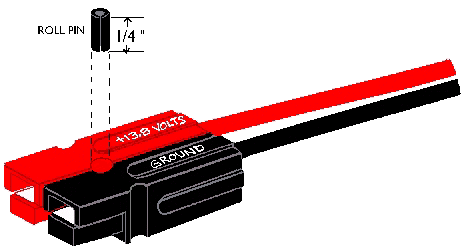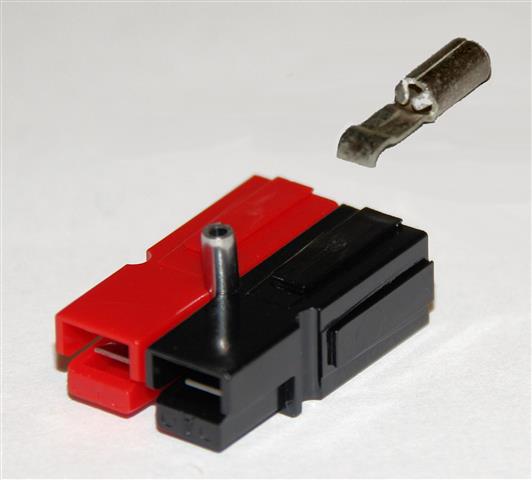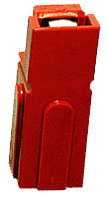

ARES/RACES Standard DC Power Connector
(High Current — 15A/30A/45A)
Anderson Powerpole®
For years hams have used "Molex" connectors as a standard to connect their radios and other equipment to power sources. The Molex connector had the drawback of being limited to about 10 amps, and were often used well beyond their ratings.
RACES and ARES organizations have now standardized on the Anderson Powerpole® for DC power connections. They offer the advantage of handling 15, 30 or 45 amps using the same connector (the contact must be matched to the current load). They are also genderless, meaning the supply and load connectors are the same, reducing the number of part required (but be careful you don't connect two different supplies!).
Either the 15-ampere or 30-ampere sizes may be used, and both sizes mate with each other. The 30A connector is preferred as it is compatible with both. The plastic housings are the same for both sizes. The barrel area (which holds the wire) of the 15-amp silver-plated contact is smaller than that of the 30-amp contact, but the contact area is the same. The connectors dovetail together into a compact unit.


Housings should be mated according to the diagram above, viewing from the contact side (opposite the wire side), tongue down, hood up, RED on the LEFT, BLACK on the RIGHT. Use a 3/32-inch-diameter roll pin, 1/4- inch long, to keep the housings from sliding apart.
Highly conductive silver-plated copper contacts allow minimal contact resistance at high currents. Self-wiping action on make and break keeps conducting surfaces clean. Contact dents keep connectors mated in high-vibration applications and provide quick-break, snap action upon disconnect.
Non-corrosive stainless-steel leaf springs maintain constant contact pressure — ideal for frequent connect/disconnect cycles and intermittent overloading. Durable, high impact-resistant, polycarbonate housing with UL94V-2 flammability ratings comes in many colors for circuit traceability and coding.
Identical connector halves are genderless, making assembly quick and easy and reducing the number of parts stocked. Molded-in dovetails allow for a customized harness in a variety of configurations. When the connectors are disconnected, no metal parts are exposed.
The 15-ampere contacts are designed for 16-20 AWG wire and the 30-ampere contacts are designed for 12-16 AWG wire. The contacts can be soldered or crimped to wires. An expensive crimping tool is available from Anderson (#1351G1, cost > $150). Inexpensive crimpers (costing about $20 at major home centers or online) can be substituted, however. After a contact has been attached to a wire, it should be installed into the housing so that the housing spring mates with the underside of the contact.
To remove a contact from the housing, use Anderson insertion/extraction tool #111038G2. You may also substitute a very small blade (e.g., a jeweler's screwdriver) to depress the spring, allowing the contact to be removed.
Here are the Anderson part numbers:
|
Recommended »» |
|

Single pole connector |

Kits, as the one shown (Red & Black shells, two contacts, and ¼" roll pin) are available from a number of vendors. |
The housings cost less than 50 cents each, and the contacts cost less than 30
cents each (2002 prices, Allied Electronics). Kits can be purchased
online, typically priced at $10 for 10, $20 for 25 sets. Make sure your
kit comes with the roll pins (used to keep the red and black housings from
separating).
The connectors can be panel mounted with clamp receptacles, consisting of two aluminum plates (Anderson part #1462G1), notched to hold the plastic housings when they are dovetailed together.
The plastic housings come in other colors also. Red and black are suggested for standard DC connectors (red as positive and black as negative). The housings have mating channels on all four sides, permitting 3, 4, or more contacts in one housing.
Anderson Power Products Web Site: http://www.andersonpower.com
(PowerPole® is a registered
trademark of Anderson Power Products)
Portions of this page, including the drawing of the assembled connector,
courtesy Orange County, CA, RACES (OCRACES)
Assembly
instructions (from Anderson's web page)
|
|
Allied Electronics
Phone: 800-433-5700
Parts #803-0100, 803-0108, 803-0125, 803-0164
http://www.alliedelec.comCable X-Perts
416 Diens Drive, Wheeling, IL 60090
Phone: 800-828-3340 (orders only) or (847) 520-3003
Fax: (847) 520-3444
http://www.cablexperts.com
e-mail: [email protected]DC Power
2870 S.W. 199th Place, Aloha, Oregon 97006
Phone: (503) 649-3295
http://www.dcpwr.com
e-mail: [email protected]PowerWerx.com
401 S. Harbor Blvd., F-320, La Habra, CA 90631
Phone: (714) 570-3303
Fax: (714) 990-5532
http://www.powerwerx.com Powerpole Page
e-mail: [email protected]West Mountain Radio (Powerpoles, RIGrunner power panel, power cords)
18 Sheehan Avenue
Norwalk, CT 06854
Phone: (203) 853-8080
Fax: (203) 299-0232
http://www.westmountainradio.com
e-mail: [email protected]
|
Page Maintained by Pete Greene, N2LVI Contact: Pete Greene, N2LVI Last Updated: 04 June 2015 © 2002-2015 N2LVI/Victor Amateur Radio Association. All rights reserved. |
Page
Accesses Since 30 June 1999: |